The Greenwood Smelter
BY: BG EDITOR
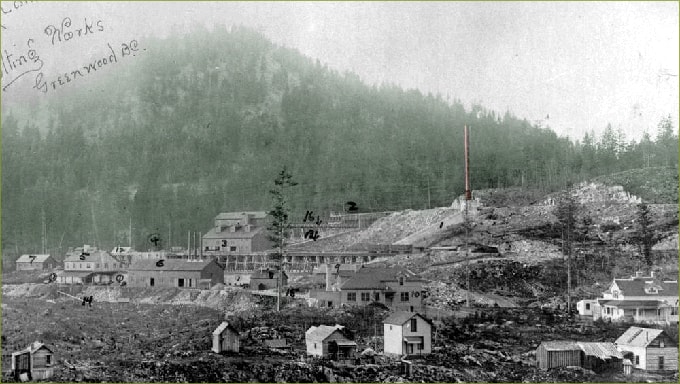
"Smelting Works, Greenwood BC", c. 1899
[ Photo: B.C. Archives #I-55686 ]
Feb 11, 2017 — GREENWOOD, BC (BG)
The symbol most widely associated with the City of Greenwood is the smelter smokestack. The B.C. Copper Company fired up the smelter in 1901 to process ore from the Mother Lode, and eventually from mines in Nelson and Rossland. This relic from the great mining days of the Boundary continues to draw both visitors and local interest.[*]
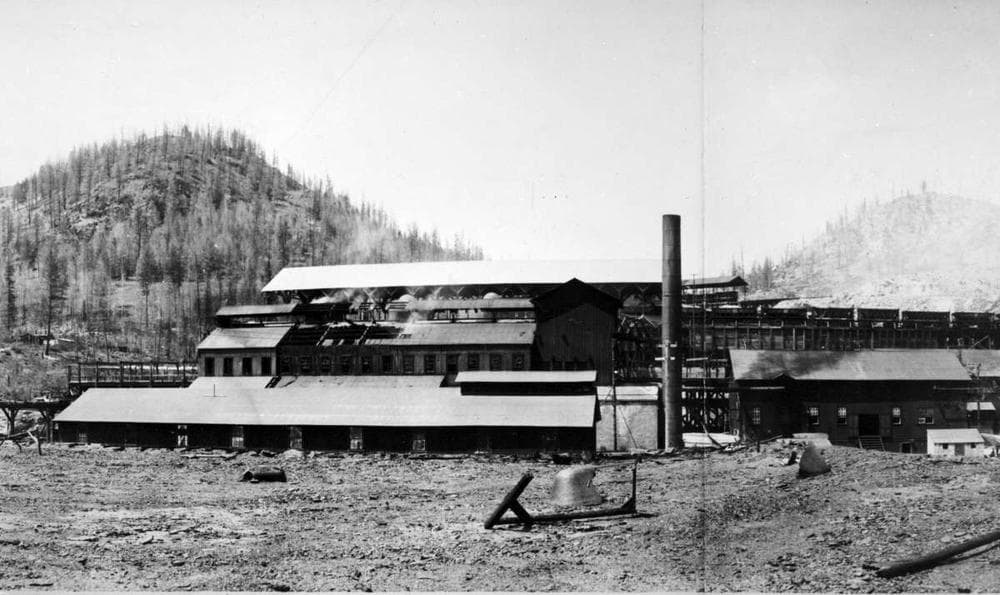
The Greenwood Smelter, c. 1906
[ Panoramic photograph by William Jefferson Carpenter — B.C. Archives #B-08500 ]
A recent article about the photographers who captured images of historic Greenwood mentioned cameraman William Jefferson Carpenter. Well known for his artistic skill in producing panoramic landscape portraits, Carpenter shot a stunning full-view panorama of the Greenwood Smelter. The image is shown here in three panels (one above and two below).
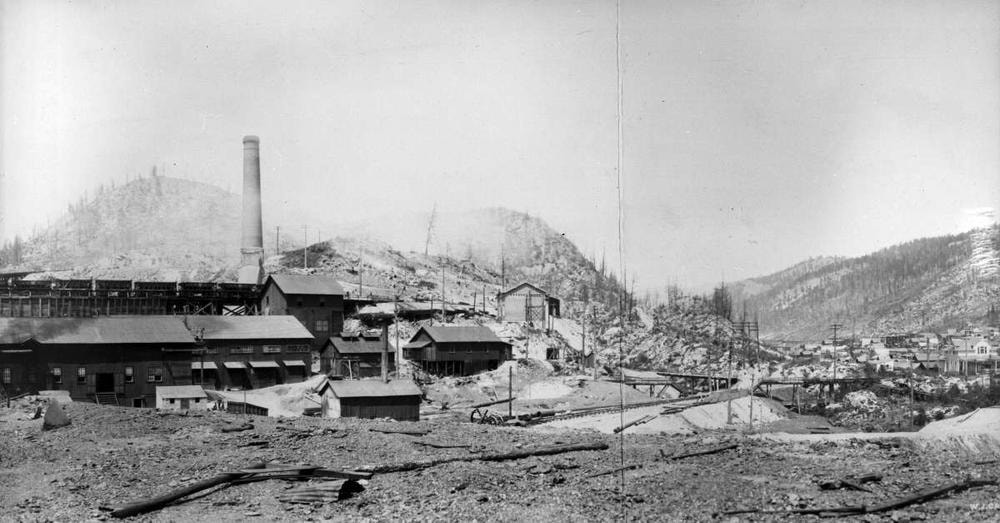
The Greenwood Smelter, c. 1906
[ Panoramic photograph by William Jefferson Carpenter — B.C. Archives #B-08501 ]
A description of the scene was given by Alfred W. G. Wilson in his 1913 book, The Copper Smelting Industries of Canada[1]. He writes:
"On the left… the converter building is prominent by reason of its corroded roof; behind this the down-combers of the three furnaces are visible beneath the roof of the furnace building. The buildings on the right are the power houses, while the main flue leading to the main stack on the hill is… in the background."
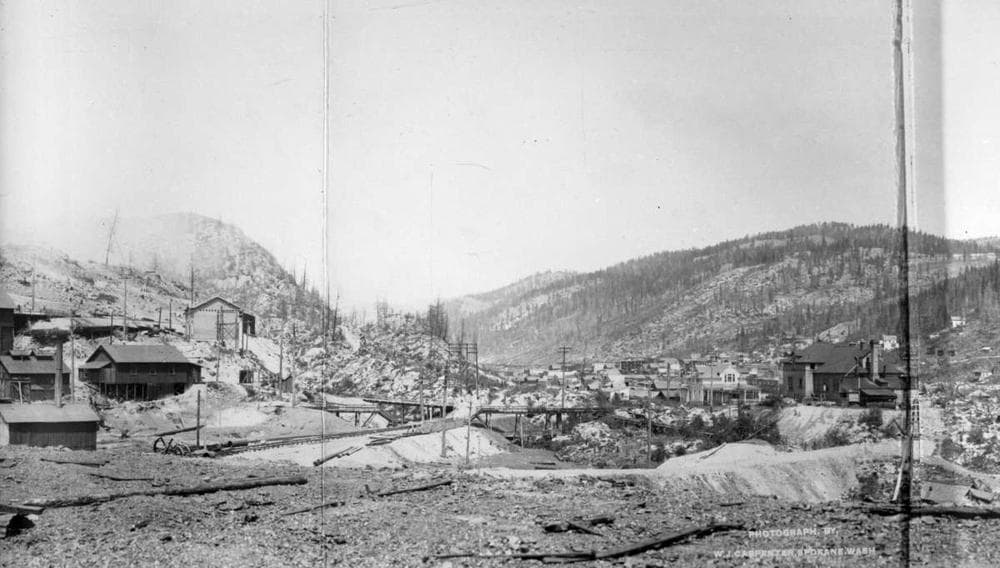
The Greenwood Smelter, c. 1906
[ Panoramic photograph by William Jefferson Carpenter — B.C. Archives #B-08502 ]
A further description of the Greenwood (Anaconda) Smelter, along with a cross-section drawing of the site, was also provided by Wilson[2]:
"The works are laid out in terraced plan. The power required is obtained from the Bonnington Falls power plants, through the
Greenwood transformer station. The smeltery is fully equipped with ore storage bins, sample mill, blast furnace plant, converter plant, briquetting plant for flue dust, machine, blacksmith, and carpenter shops, power house, and an efficient water supply for all purposes…"
On February 21, 1901, a few days after the smelter was first fired-up and put into production, a story announcing the momentous event was published in the Greenwood Weekly Times[3]:
SMELTER IS RUNNING
"After many annoying, but unavoidable delays, the "blowing in" of the smelter of the British Columbia Copper company was finally accomplished on Monday. At 7:30 p.m. the big furnace was fired up and in exactly 50 minutes after, molten ore commenced to flow through the trapped spout into the foreheath. Since then everything has been working smoothly, as though the plant had been in operation for months. Throughout the day a steady stream of sightseers were on hand to watch operations and to heartily congratulate Manager Paul Johnson, E.M., on the success of the initial run.
A full description of the plant was given in the last issue of the Times and there is little to add to it. Greenwood has a smelter that it can justly be proud of — a monument to the growth of the mining industry of the Boundary. It is planned with a view to an ultimate addition of five more furnaces, and the treatment of 2,000 tons of ore per day. Before many weeks go by a second furnace will be installed. Sometime during the summer, so Mr. Underwood, a director of the company, informed the Times when here recently, a converting plant will be installed. The contract for the machinery has already been let to the E. P. Allis company, of Milwaukee.
Beside about 8,000 tons of Mother Lode ore on hand shipments have been received from the Gold Bug, Little Bertha and No. 7. There is sufficient supply of both coal and coke to insure a steady running, and unless the unforeseen happens, there will be no interruptions from now on. No alarm need be felt about the fumes from the smoke-stack. It was built high enough to carry same above the town, and moreover the prevailing winds carry the fumes up the draw formed by Copper creek. Vegetation will not suffer."
We also find in the Weekly Times on this grand day in February 1901, when the smelter came online, an editorial[3] that offers a fascinating narrative on Greenwood's growth as a mining centre. The launch of the smelter came after what had been a difficult economic time — the period immediately after the railroads were pushed through.
GREENWOOD'S GROWING TIME
"The rubicon has been crossed. Greenwood has entered an era of prosperity which is not based on any temporary boom but on the permanency of the mineral resources of the district, and the successful operation of industrial enterprises. The dullness of trade during the last few months was the natural reaction after a season of remarkable activity. The expenditure of millions of dollars on railway construction within a limited area made business exceptionally brisk in the towns directly affected. As is customary in such cases, business men did not give sufficient thought for the future and acted as if these conditions were permanent. When the railway was completed the reaction set in. The mineral resources were not sufficiently developed to furnish a sufficient business to maintain the volume in construction days. It was surprising under the circumstances that there have been but few failures.
Since the completion of the railway the district has been rapidly developed. Mines have been placed on a shipping basis, smelters constructed and other industrial enterprises started. The future of the district is assured. Business is now on a solid, permanent basis. With mines about whose wealth there is now not the slightest doubt, with smelters treating the ore right at home, all giving employment to a large number of men, there is indeed a bright prospect for the city.
The blowing in of the Greenwood smelter is the beginning of a new era in the history of the city. Quickly upon this will follow the operation of the Standard Pyritic smelter. Work will shortly start on the construction of the tramway. The future greatness of the city is being worked out as quickly as could be expected and while a season of hard times was inconvenient and unpleasant, those who had the grit to stay with the town have now their reward in the absolute certainty of conditions as satisfactory as can be found in any city in the world. While experience is a stern tutor, it is also a wise one. Many invaluable lessons were taught during the season of depression which cannot but assist in placing the city and its business men on a more solid basis than ever.
The Times cannot be accused of booming or boasting. It was confident of the future of the city and was satisfied to wait until the turning point came. Now that it has come we can safely say without fear of contradiction that Greenwood is what it was destined to be, the mining, smelting, commercial, and financial center of the Boundary district."
And in the same edition of the Times[4], we find this advertisement for a special souvenir spoon that was produced to mark the occasion of the smelter coming online:
A recent auction record[5] for one of these spoons describes it as having an "enameled finial with crown (green, red, blue enamel), crest with shovel, pick, hammer on blue background, decorative stem, gilded bowl with embossed view of "B.C. Copper Co's Smelter. Greenwood, B.C. 1901." Sterling. Length: 4-1/2 inches. Entire spoon is gilded.
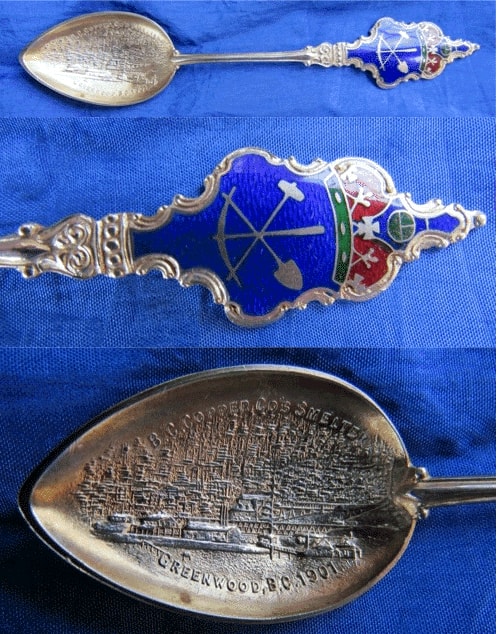
Greenwood Smelter Souvenir Spoon
FOOTNOTES:
[1] The Copper Smelting Industries of Canada by Alfred W. G. Wilson, 1913
[2] Ibid, P. 121
[5] Souvenir Spoon — The Campanian Society and American Spoon Collectors
http://www.campanian.org
REFERENCES:
"Steam Along the Boundary" by Robert D. Turner and J. S. David Wilkie, p. 102, 107
[*] Frank Schlichting, who produced the video linked above, will be speaking at the 66th Anniversary Luncheon of the Boundary Historical Society, February 18, 2017.










